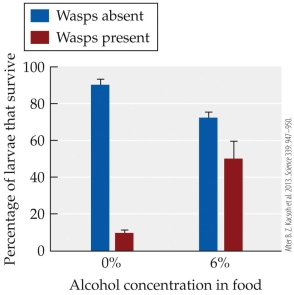Refer to the figure. Females of certain parasitoid wasps lay their eggs on the larvae of female Drosophila melanogaster fruit flies and the hatched wasp larvae burrow through the fly larva, consuming and killing it. Fruit fly larvae sometimes feed on high alcohol food sources, such as rotting fruit, and are harmed by the alcohol-but any wasp larvae inside them are harmed even more. Kacsoh et al. (2013) found that when wasps were present, adult female fruit flies laid more than 90% of their eggs in high-alcohol foods, whereas when wasps were absent, they laid around 40% of their eggs in high-alcohol foods. Given this background and the experimental data in the figure, which of the following statements is true?
Females of certain parasitoid wasps lay their eggs on the larvae of female Drosophila melanogaster fruit flies and the hatched wasp larvae burrow through the fly larva, consuming and killing it. Fruit fly larvae sometimes feed on high alcohol food sources, such as rotting fruit, and are harmed by the alcohol-but any wasp larvae inside them are harmed even more. Kacsoh et al. (2013) found that when wasps were present, adult female fruit flies laid more than 90% of their eggs in high-alcohol foods, whereas when wasps were absent, they laid around 40% of their eggs in high-alcohol foods. Given this background and the experimental data in the figure, which of the following statements is true?
A) The different egg-laying behavior of female fruit flies in the presence and absence of wasps appears to be adaptive.
B) Based on the data shown, female fruit flies could increase the survival of their offspring if they always laid eggs in alcohol-rich foods.
C) Based on the data shown, female fruit flies could increase the survival of their offspring if they never laid eggs in alcohol-rich foods.
D) Based on the data shown, female wasps could increase the survival of their offspring if they always laid their eggs on fruit fly larvae feeding on high-alcohol foods.
Correct Answer:
Verified
Q39: Which scenario would likely result in the


